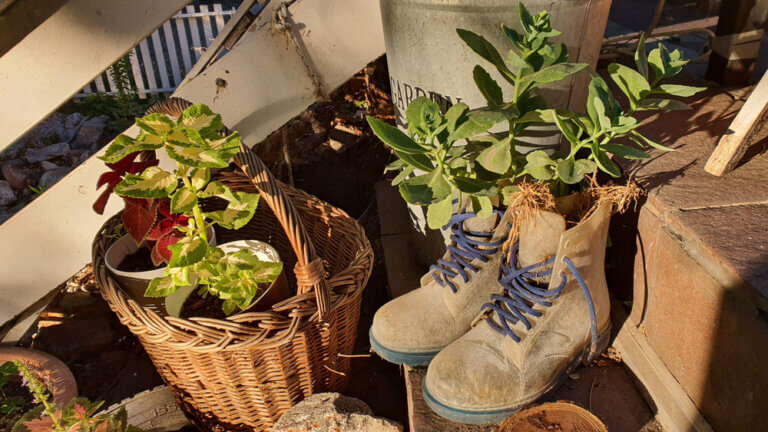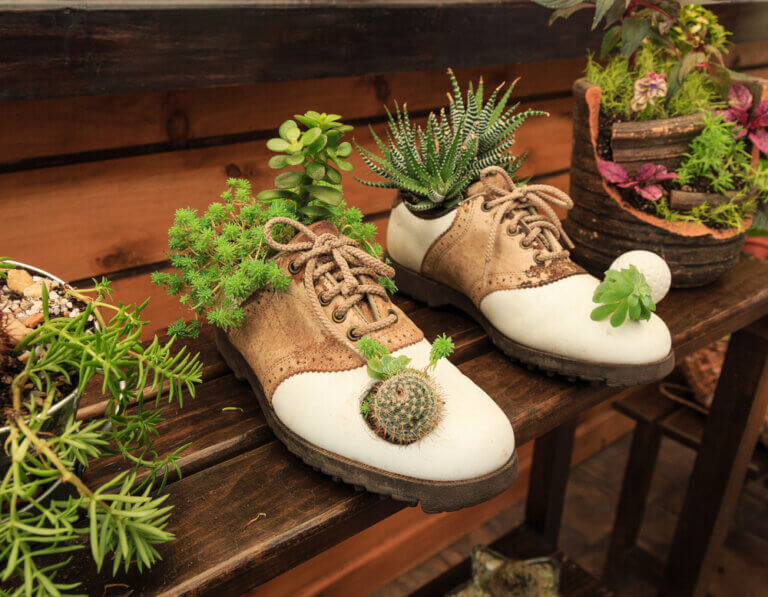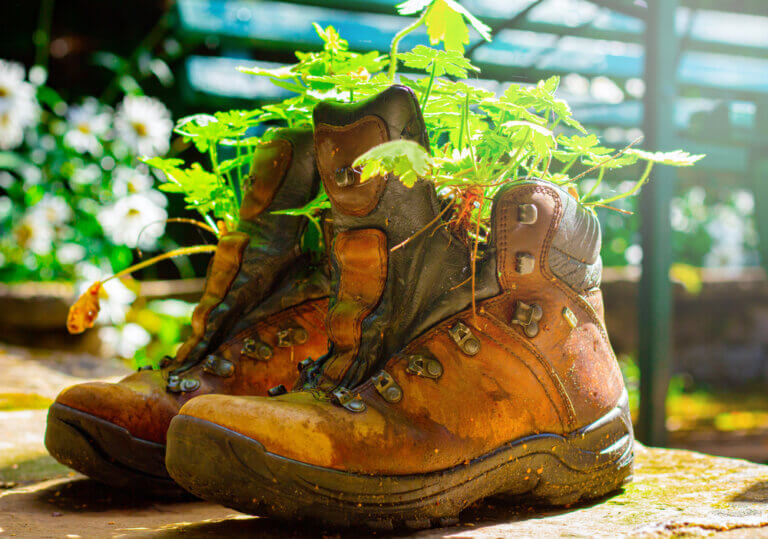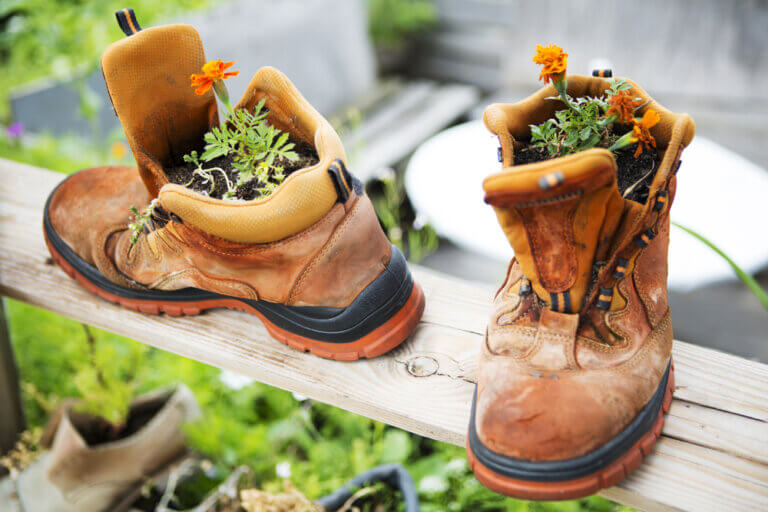Reuse Your Boots and Sneakers as Flower Pots

We can do two things with the clothes that we don’t use, and won’t use, anymore: recycle them for a new purpose ourselves or throw them in a used clothes bin. You can come up with a lot of ideas with recycled clothing and footwear, but today, we’re going to show you one in particular: repurposing boots and shoes as flower pots.
Repurposing old shirts as rags isn’t the only thing you can do. Other articles can find a second life as something useful or decorative for your home.
All you need is some creativity and a good eye. While some articles aren’t the best choices for decor, they can still play a role in settings and offer something different and attractive.
Boots and shoes as flower pots

It might seem a little paradoxical and odd, but converting boots and shoes into flower pots can be a very original idea that works visually for decor. In fact, they’re an idea that you won’t see very often in homes and gardens.
Generally speaking, when we visit a public space and see these kinds of original ideas, we’re surprised and enjoy it because it’s creative, stepping out of the norms for decor.
So, we need to try to innovate and look for more interesting solutions to keep our days from being monotone.
— Surprise your guests with a decor that breaks free from norms.–
Normal boots and rain boots

An old pair of boots that you don’t use anymore is the perfect container for plants. In fact, the more worn-out, the better. That way, they’ll give off a stronger feel of wear and tear. So, what do you need to know to get started?
- You should be able to fill them with dirt and plant flowers. But they aren’t suitable for plants for consumption.
- The plant needs to grow into the boot, growing roots and settling into the space.
- Because we’re talking about waterproof boots, it’s a good idea to make holes in the sole to allow for drainage and respiration, preventing the plant from drowning.
As for rain boots, they’re a great option for various reasons: they’re usually colorful, taller than normal boots while being more resilient because they’re made of plastic.
- Fill them with plenty of dirt and plant flowers at surface-level.
- Make some holes in the soles so the plants can breathe from underneath.
- If you’re using boots that are smooth and a solid color, you can add on some decorative motifs with paint to make them all the more unique.
Sneakers as flower pots

You might not think so at first but brand name sneakers, like Nike, Adidas, Puma, etc. can be a great decor. Besides, they usually wear out faster than boots because we use them more, thus recycling more pairs in a year.
- Open the sneaker nice and wide. Sneakers are smaller than boots and will need to be stretched out more to fit enough dirt and provide enough vital space for the plant.
- Don’t choose plants that are too big. Smaller plants will work better here, like flowers, cacti or even a bonsai.
- The sneaker soles are weaker than boots, but you’ll still need to make some holes for transpiration as well as to prevent excess water.
- You can decorate the sneakers by painting them or aging them. What wouldn’t work here, though, is a shoe that’s in perfect condition.
— By recycling our clothes and shoes, you’ll be helping the planet.–
Best spots for the flower pots
There are different spots around your home where you can place these flower pots. But keep in mind that their originality will turn heads and draw interest.
- An ideal place is the garden: gardens are a perfect spot to let them harmonize with the rest of your vegetation and share a dialogue with the other greens, like your lawn.
- A patio is also a great spot for them because these pots break the typical dynamic of clay pots and planters. They’ll walk off the normal path and open the door to new decor.
- In the living room: though living rooms usually house more elegance, these flower pots can also serve as a decorative piece.
We can do two things with the clothes that we don’t use, and won’t use, anymore: recycle them for a new purpose ourselves or throw them in a used clothes bin. You can come up with a lot of ideas with recycled clothing and footwear, but today, we’re going to show you one in particular: repurposing boots and shoes as flower pots.
Repurposing old shirts as rags isn’t the only thing you can do. Other articles can find a second life as something useful or decorative for your home.
All you need is some creativity and a good eye. While some articles aren’t the best choices for decor, they can still play a role in settings and offer something different and attractive.
Boots and shoes as flower pots

It might seem a little paradoxical and odd, but converting boots and shoes into flower pots can be a very original idea that works visually for decor. In fact, they’re an idea that you won’t see very often in homes and gardens.
Generally speaking, when we visit a public space and see these kinds of original ideas, we’re surprised and enjoy it because it’s creative, stepping out of the norms for decor.
So, we need to try to innovate and look for more interesting solutions to keep our days from being monotone.
— Surprise your guests with a decor that breaks free from norms.–
Normal boots and rain boots

An old pair of boots that you don’t use anymore is the perfect container for plants. In fact, the more worn-out, the better. That way, they’ll give off a stronger feel of wear and tear. So, what do you need to know to get started?
- You should be able to fill them with dirt and plant flowers. But they aren’t suitable for plants for consumption.
- The plant needs to grow into the boot, growing roots and settling into the space.
- Because we’re talking about waterproof boots, it’s a good idea to make holes in the sole to allow for drainage and respiration, preventing the plant from drowning.
As for rain boots, they’re a great option for various reasons: they’re usually colorful, taller than normal boots while being more resilient because they’re made of plastic.
- Fill them with plenty of dirt and plant flowers at surface-level.
- Make some holes in the soles so the plants can breathe from underneath.
- If you’re using boots that are smooth and a solid color, you can add on some decorative motifs with paint to make them all the more unique.
Sneakers as flower pots

You might not think so at first but brand name sneakers, like Nike, Adidas, Puma, etc. can be a great decor. Besides, they usually wear out faster than boots because we use them more, thus recycling more pairs in a year.
- Open the sneaker nice and wide. Sneakers are smaller than boots and will need to be stretched out more to fit enough dirt and provide enough vital space for the plant.
- Don’t choose plants that are too big. Smaller plants will work better here, like flowers, cacti or even a bonsai.
- The sneaker soles are weaker than boots, but you’ll still need to make some holes for transpiration as well as to prevent excess water.
- You can decorate the sneakers by painting them or aging them. What wouldn’t work here, though, is a shoe that’s in perfect condition.
— By recycling our clothes and shoes, you’ll be helping the planet.–
Best spots for the flower pots
There are different spots around your home where you can place these flower pots. But keep in mind that their originality will turn heads and draw interest.
- An ideal place is the garden: gardens are a perfect spot to let them harmonize with the rest of your vegetation and share a dialogue with the other greens, like your lawn.
- A patio is also a great spot for them because these pots break the typical dynamic of clay pots and planters. They’ll walk off the normal path and open the door to new decor.
- In the living room: though living rooms usually house more elegance, these flower pots can also serve as a decorative piece.
All cited sources were thoroughly reviewed by our team to ensure their quality, reliability, currency, and validity. The bibliography of this article was considered reliable and of academic or scientific accuracy.
Schor, J. D. (1984). ‘Wabi-Sabi.’ JAMA: The Journal of the American Medical Association. https://doi.org/10.1001/jama.1984.03350220079040







